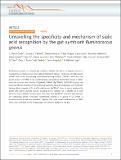Files in this item
Unravelling the specificity and mechanism of sialic acid recognition by the gut symbiont Ruminococcus gnavus
Item metadata
| dc.contributor.author | Owen, C. David | |
| dc.contributor.author | Tailford, Louise E | |
| dc.contributor.author | Monaco, Serena | |
| dc.contributor.author | Šuligoj, Tanja | |
| dc.contributor.author | Vaux, Laura | |
| dc.contributor.author | Lallement, Romane | |
| dc.contributor.author | Khedri, Zahra | |
| dc.contributor.author | Yu, Hai | |
| dc.contributor.author | Lecointe, Karine | |
| dc.contributor.author | Walshaw, John | |
| dc.contributor.author | Tribolo, Sandra | |
| dc.contributor.author | Horrex, Marc | |
| dc.contributor.author | Bell, Andrew | |
| dc.contributor.author | Chen, Xi | |
| dc.contributor.author | Taylor, Garry L | |
| dc.contributor.author | Varki, Ajit | |
| dc.contributor.author | Angulo, Jesus | |
| dc.contributor.author | Juge, Nathalie | |
| dc.date.accessioned | 2018-01-05T10:30:11Z | |
| dc.date.available | 2018-01-05T10:30:11Z | |
| dc.date.issued | 2017-12-19 | |
| dc.identifier | 251880416 | |
| dc.identifier | 78871d25-1993-416e-b5c0-210de180b284 | |
| dc.identifier | 29259165 | |
| dc.identifier | 85038615602 | |
| dc.identifier | 000418336800001 | |
| dc.identifier.citation | Owen , C D , Tailford , L E , Monaco , S , Šuligoj , T , Vaux , L , Lallement , R , Khedri , Z , Yu , H , Lecointe , K , Walshaw , J , Tribolo , S , Horrex , M , Bell , A , Chen , X , Taylor , G L , Varki , A , Angulo , J & Juge , N 2017 , ' Unravelling the specificity and mechanism of sialic acid recognition by the gut symbiont Ruminococcus gnavus ' , Nature Communications , vol. 8 , 2196 , pp. 1-15 . https://doi.org/10.1038/s41467-017-02109-8 | en |
| dc.identifier.issn | 2041-1723 | |
| dc.identifier.other | PubMedCentral: PMC5736709 | |
| dc.identifier.other | ORCID: /0000-0001-9486-566X/work/60428044 | |
| dc.identifier.uri | https://hdl.handle.net/10023/12436 | |
| dc.description | The authors gratefully acknowledge the support of the Biotechnology and Biological Sciences Research Council (BBSRC), this research was funded by the BBSRC Institute Strategic Programme for The Gut Health and Food Safety (BB/J004529/1), the BB/F016778/1 grant, and by the US National Institutes of Health (NIH) of grant R01HD065122 (to X.C.) and R01GM32373 (to A.V.). S.M. and J.A. acknowledge a postgraduate studentship and financial support from the School of Pharmacy of the University of East Anglia. | en |
| dc.description.abstract | Ruminococcus gnavus is a human gut symbiont wherein the ability to degrade mucins is mediated by an intramolecular trans-sialidase (RgNanH). RgNanH comprises a GH33 catalytic domain and a sialic acid-binding carbohydrate-binding module (CBM40). Here we used glycan arrays, STD NMR, X-ray crystallography, mutagenesis and binding assays to determine the structure and function of RgNanH_CBM40 (RgCBM40). RgCBM40 displays the canonical CBM40 β-sandwich fold and broad specificity towards sialoglycans with millimolar binding affinity towards α2,3- or α2,6-sialyllactose. RgCBM40 binds to mucus produced by goblet cells and to purified mucins, providing direct evidence for a CBM40 as a novel bacterial mucus adhesin. Bioinformatics data show that RgCBM40 canonical type domains are widespread among Firmicutes. Furthermore, binding of R. gnavus ATCC 29149 to intestinal mucus is sialic acid mediated. Together, this study reveals novel features of CBMs which may contribute to the biogeography of symbiotic bacteria in the gut. | |
| dc.format.extent | 15 | |
| dc.format.extent | 6587988 | |
| dc.language.iso | eng | |
| dc.relation.ispartof | Nature Communications | en |
| dc.subject | R Medicine | en |
| dc.subject | QH301 Biology | en |
| dc.subject | QD Chemistry | en |
| dc.subject | DAS | en |
| dc.subject.lcc | R | en |
| dc.subject.lcc | QH301 | en |
| dc.subject.lcc | QD | en |
| dc.title | Unravelling the specificity and mechanism of sialic acid recognition by the gut symbiont Ruminococcus gnavus | en |
| dc.type | Journal article | en |
| dc.contributor.institution | University of St Andrews. Office of the Principal | en |
| dc.contributor.institution | University of St Andrews. School of Biology | en |
| dc.contributor.institution | University of St Andrews. Biomedical Sciences Research Complex | en |
| dc.identifier.doi | 10.1038/s41467-017-02109-8 | |
| dc.description.status | Peer reviewed | en |
This item appears in the following Collection(s)
Items in the St Andrews Research Repository are protected by copyright, with all rights reserved, unless otherwise indicated.

